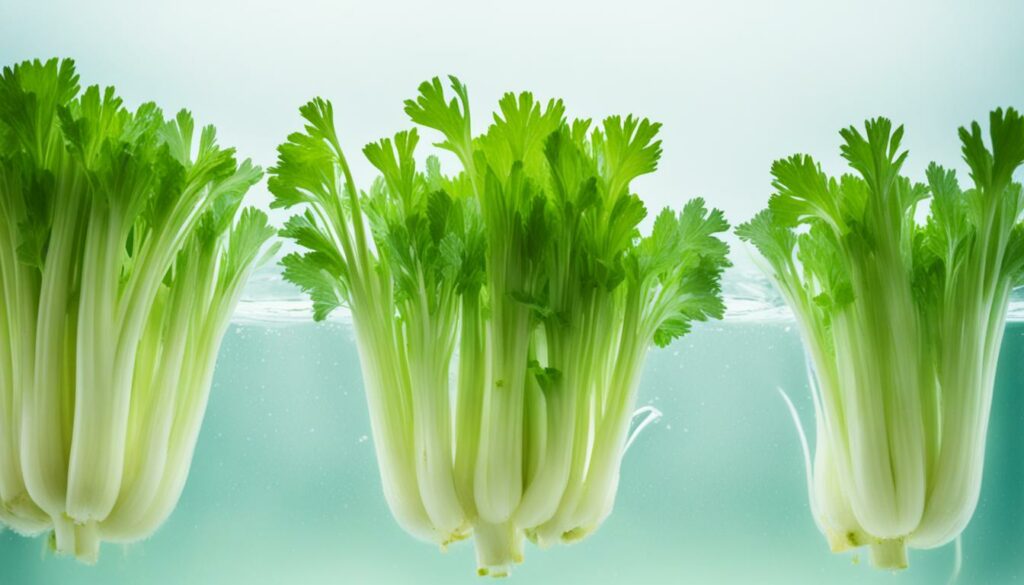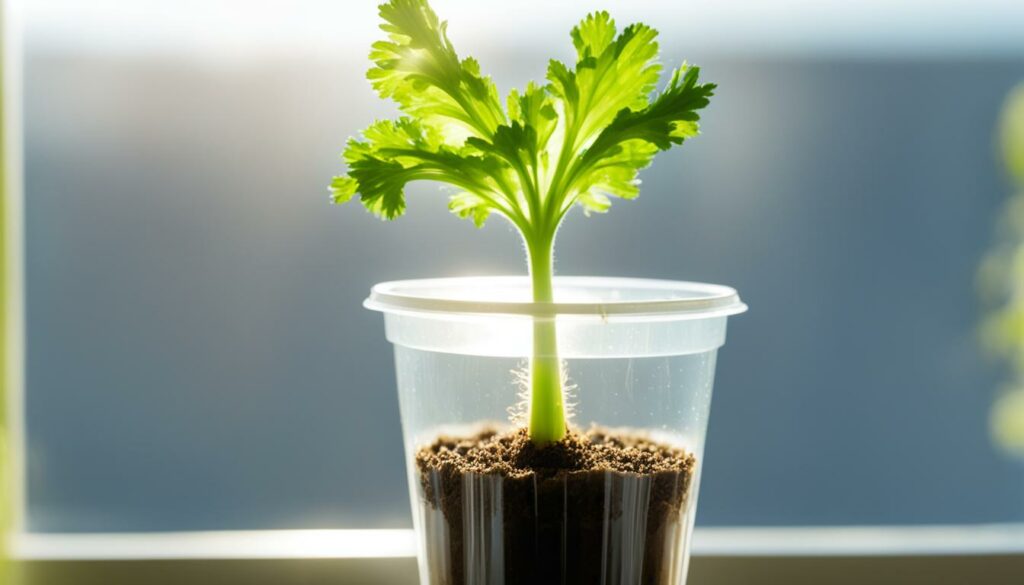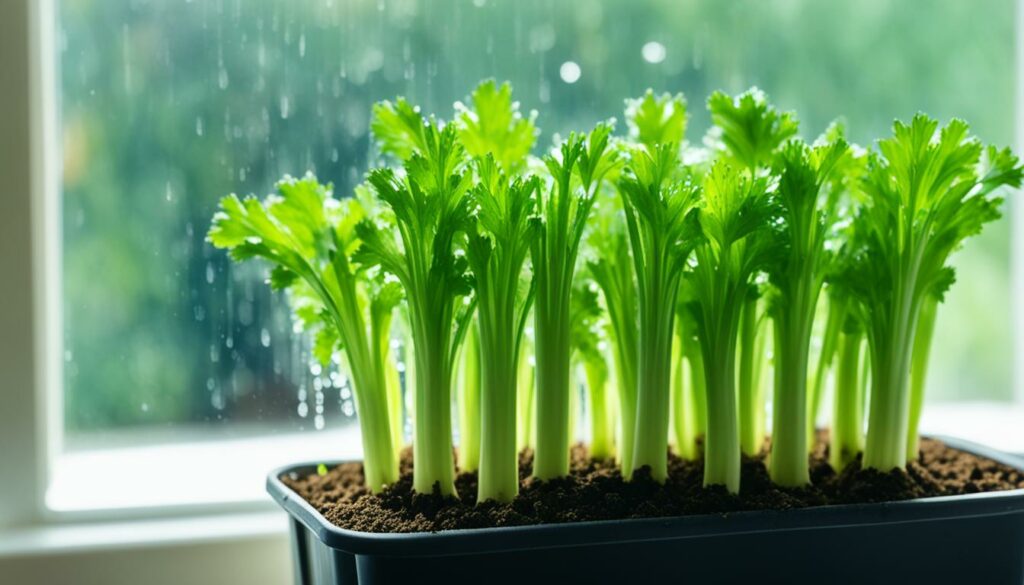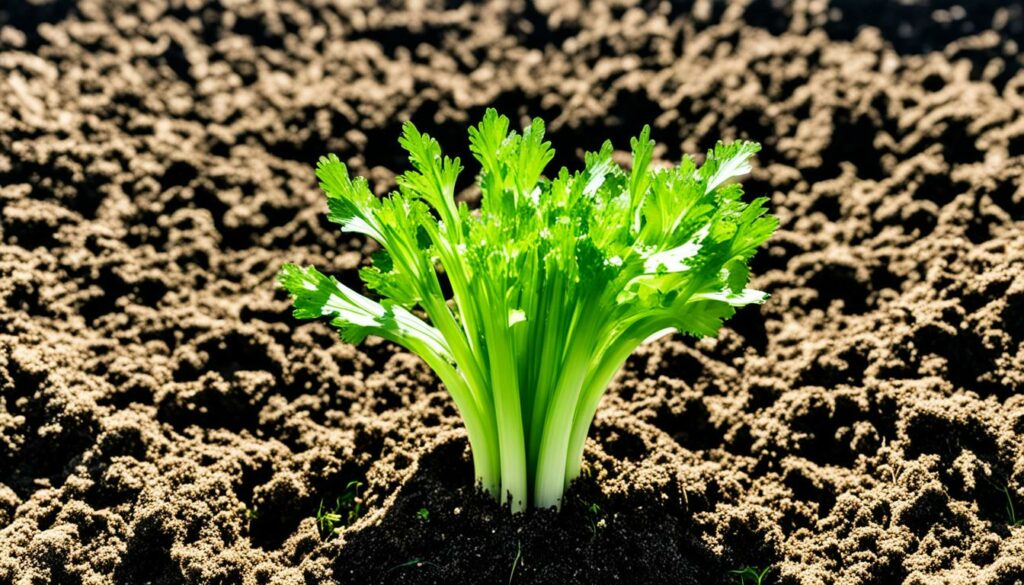Regrowing celery from grocery store scraps is a simple and rewarding process that allows you to transform kitchen leftovers into fresh celery stalks. Not only is it a great way to reduce waste, but it also saves money and provides the satisfaction of growing your own vegetables. Plus, this method can be applied to regrow other vegetables from scraps as well.
Table of Contents
Key Takeaways:
- Regrowing celery from grocery store scraps is a sustainable way to reduce waste.
- You can save money by growing your own fresh celery instead of buying it from the store.
- This process can also be applied to regrow other vegetables from scraps.
- Regrowing celery teaches valuable lessons about plant propagation and self-sustainability.
- With proper care, regrown celery will continue to grow and produce more stalks.
Why Regrow Celery?
Regrowing celery provides numerous benefits, from reducing waste to saving money and enjoying the satisfaction of homegrown produce. By utilizing the leftover parts of the vegetable, you can contribute to a more sustainable lifestyle and enhance your gardening skills. Let’s explore the reasons why regrowing celery is a rewarding endeavor.
Reducing Waste and Saving Money
One of the primary advantages of regrowing celery is the ability to minimize food waste. Instead of discarding the root ends and leftover stalks, you can transform them into new, vibrant celery plants. This not only helps reduce the amount of organic waste in your household but also saves you money. By producing your own celery, you won’t have to purchase it from the store, leading to significant long-term savings.
“Regrowing celery is an excellent way to reduce waste and save money. It’s a win-win situation.”
Fun and Educational Project
Regrowing celery is a fun and engaging project that can be enjoyed by gardening enthusiasts of all ages. It offers an opportunity to learn about plant propagation and explore the wonders of nature. Watching the celery scraps transform into new plants and witnessing the growth process firsthand is not only exciting but also educational. It provides a valuable lesson in self-sustainability and promotes a deeper appreciation for the natural world.
Homegrown Freshness and Flavor
When you regrow celery, you have complete control over its growing conditions, ensuring optimal freshness and flavor. The homegrown celery tends to be more vibrant and flavorful compared to store-bought varieties. Additionally, knowing that you’ve nurtured the plant from its initial stages makes it even more rewarding to savor the crisp texture and delicious taste of your homegrown celery.

As you can see, regrowing celery offers a range of benefits, from reducing waste to enjoying the fresh flavors of homegrown produce. So, why not give it a try and embark on an exciting journey of celery regrowth and sustenance?
How to Regrow Celery from Grocery Store
To regrow celery from grocery store leftovers, follow these simple steps:
- Cut the celery: Start by cutting about 2 inches off the root end of a bunch of celery. This will be the part that you will use to regrow.
- Optional: Use toothpicks: If you want to suspend the celery in a container, you can insert toothpicks into the base to hold it up. This step is not necessary but can be helpful if you want to observe the regrowth more easily.
- Place in water: Next, place the celery root end in a shallow glass bowl or jar filled with about an inch of water. Make sure the root end is in the water, while the top part remains above the water level.
- Change water regularly: Change the water every few days to prevent stagnation and maintain freshness. It’s essential to keep the root end submerged to facilitate regrowth.
- Observe regrowth: After a few days, you’ll start to see leaves and small stalks emerging from the center of the celery. This is a sign that the regrowing process is successful!
Regrowing celery from kitchen scraps is a fun and rewarding project that allows you to enjoy the benefits of homegrown produce. By following these steps and providing proper care, you can watch your celery regrow and thrive.
Remember to be patient and provide the necessary conditions for growth, such as adequate sunlight, water, and nutrients. With time, you’ll be able to harvest fresh celery from your regrown plant and enjoy its crisp texture and delicious flavor.
| Benefits of Regrowing Celery from Grocery Store |
|---|
| Reduces food waste |
| Saves money |
| Fun and educational project |
| Teaches about plant propagation |
| Provides fresh, homegrown celery |
Transferring Celery to Soil
Once the celery base has sprouted leaves and small stalks, it’s time to transfer it to soil. This step is essential for the continued growth and development of your regrown celery. Follow these simple steps to successfully plant your celery:
- Prepare a pot or choose a garden spot with rich, well-draining soil. Celery prefers soil that is loose and fertile.
- Plant the celery base into the soil, making sure it is covered up to the cut end. This will provide stability and encourage root growth.
- Water the soil thoroughly to ensure moisture reaches the roots. Celery requires consistent moisture, but avoid overwatering as it can lead to root rot.
- Place your celery plant in an area that receives adequate sunlight. While celery can tolerate some shade, it thrives in full sun or partial shade.
- Maintain a cool environment for your celery plant by providing shade during the hottest part of the day. This helps prevent the stalks from becoming tough or bitter.
With proper care and attention, your regrown celery will continue to grow and produce more stalks, providing you with a fresh and homegrown harvest.
Expert Tip:
When choosing a pot for your celery, opt for one that is at least 10-12 inches deep to accommodate the growth of the celery roots.
Table: Comparison of Soil Types for Growing Celery
| Soil Type | Advantages | Disadvantages |
|---|---|---|
| Loamy Soil | Retains moisture well | May require additional amendments to improve drainage |
| Sandy Soil | Provides good drainage | Needs frequent watering to prevent drying out |
| Clay Soil | Rich in nutrients | Can become compacted and drain poorly |
| Compost-Enriched Soil | Improves soil structure and fertility | May require regular additions of compost |

By transplanting your regrown celery to the soil, you provide it with the necessary stability and nutrients for continued growth. Follow the care instructions outlined in this section to ensure the success of your celery plants.
Tips for Growing Regrown Celery
To ensure successful growth of regrown celery, it’s important to provide the plant with proper care and attention. Here are some tips to help you grow healthy and vibrant celery from kitchen scraps:
- Provide Adequate Sunlight: Celery thrives in full sun but can tolerate some shade. Make sure to place your regrown celery in a sunny location where it can receive at least 6-8 hours of direct sunlight each day.
- Water Regularly: Celery requires consistent moisture to grow, so make sure to water your celery regularly. Keep the soil evenly moist, but be cautious not to overwater as this can lead to root rot. Stick your finger into the soil to check for moisture before watering. If it feels dry up to your first knuckle, it’s time to water.
- Fertilize with Balanced Fertilizer: Apply a balanced fertilizer to your regrown celery as directed to provide it with essential nutrients. This will help promote healthy growth and ensure that your celery is well-nourished.
- Mulch the Soil: Mulching around the base of the celery plant can help conserve moisture and suppress the growth of weeds. Apply a layer of organic mulch, such as straw or shredded leaves, around the plant, leaving a few inches of space around the base to avoid trapping moisture against the celery stems.
- Monitor for Pests and Diseases: Regularly inspect your regrown celery for any signs of pests or diseases. Common celery pests include aphids, slugs, and snails. If you notice any issues, take appropriate measures to control and eliminate the problem. Organic methods, such as handpicking pests or using insecticidal soaps, are preferred for growing celery.
By following these tips, you can ensure that your regrown celery thrives and produces delicious stalks that you can enjoy in your favorite recipes.

| Tips for Growing Regrown Celery |
|---|
| Provide Adequate Sunlight |
| Water Regularly |
| Fertilize with Balanced Fertilizer |
| Mulch the Soil |
| Monitor for Pests and Diseases |
Harvesting Regrown Celery
After patiently nurturing your regrown celery plant, it’s finally time to reap the rewards of your efforts. Harvesting regrown celery is a simple process that allows you to enjoy the freshness of homegrown produce. Here’s how you can harvest your regrown celery:
- Identify mature stalks: As your regrown celery plant reaches maturity, you’ll notice that the outer stalks have grown tall and thick.
- Snapping off the stalks: To harvest, simply grab the outer stalk at its base and snap it off from the plant. Be gentle but firm to ensure a clean break.
- Leaving inner stalks: Leave the inner stalks and leaves untouched. These will continue to grow and provide a continuous supply of fresh celery.
It’s important to note that the stalks of regrown celery may not be as tough and fibrous as store-bought celery. However, they will still have a crisp texture and a similar flavor. Harvesting can be done as needed, allowing you to enjoy freshly picked celery from your own garden.

Benefits of Harvesting Regrown Celery
Harvesting regrown celery offers numerous benefits:
- Freshness: Harvesting at home ensures that you have access to fresh celery whenever you need it.
- Cost-saving: By regrowing celery from kitchen scraps, you save money by not having to purchase celery from the store.
- Sustainability: Regrowing celery promotes sustainability by reducing food waste and utilizing scraps to produce edible plants.
- Customization: You have control over the growing conditions and can avoid using pesticides or other chemicals, resulting in healthier celery.
Now that you know how to harvest regrown celery, you can enjoy the satisfaction of growing your own vegetables from kitchen scraps.
Regrowing Celery Roots
When you regrow celery from grocery store scraps, the plant undergoes a fascinating transformation. As it grows, new roots begin to develop and extend downwards into the water or soil. These roots play a crucial role in supporting the plant and ensuring its continued growth and vitality. This unique feature sets regrowing celery apart from many other kitchen scrap gardening projects, as it allows for the transfer of the plant into the garden.
The development of these new roots is a sign that your regrown celery is thriving and adapting to its new environment. It’s a testament to the resilience and versatility of this humble vegetable. By providing the proper care and conditions, you can witness the remarkable regrowth and root development firsthand.
Watching the roots grow and elongate is not only visually captivating but also an important reminder of the plant’s ability to regenerate and sustain its own growth. Each new root represents a connection to the soil or water, drawing in vital nutrients and moisture to support the plant’s overall health.
Regrowing celery roots from grocery store scraps is a rewarding process that allows you to witness the wonders of nature in your own home. It’s a tangible representation of the plant’s life cycle and a testament to the power of regeneration within the plant kingdom.
Taking Care of Regrowing Celery Roots
While the roots of regrown celery play an essential role in supporting the plant, it’s important to provide them with the care they need to thrive. Here are some tips for taking care of regrowing celery roots:
- Ensure the roots are consistently submerged in water or planted in moist soil to maintain proper hydration.
- Avoid overwatering, as excessive moisture can lead to root rot and hinder root development.
- Provide the plant with adequate sunlight or shade, depending on its specific requirements.
- Monitor the growth of the roots and adjust the water level or soil moisture accordingly.
- Regularly inspect the roots for signs of pests or diseases and take appropriate measures to address any issues.
By giving proper attention to the roots of your regrowing celery, you can ensure the continued growth and success of your plant.
Benefits of Regrowing Celery
Regrowing celery from grocery store scraps offers numerous benefits that go beyond simply reducing waste. Here are some key advantages:
1. Sustainability and Self-Sufficiency
“Regrowing celery allows you to have a sustainable source of fresh vegetables right at home. By reusing kitchen scraps, you contribute to a greener planet and reduce your carbon footprint.”
Investing time and effort in regrowing celery promotes self-sufficiency and empowers you to take control of your food production. It’s a rewarding experience that teaches valuable lessons about plant propagation and gardening techniques.
2. Cost Savings
“By regrowing celery from kitchen scraps, you can save money on regularly purchasing fresh produce. Instead of discarding the base of the celery, you can transform it into a fully grown plant, yielding a continuous supply of celery stalks.”
With minimal investment in water, soil, and sunlight, you can enjoy a sustainable and cost-effective source of fresh celery, right from your own garden or kitchen window.
3. Educational and Fun Project
“Regrowing celery is an excellent educational project suitable for all ages. It provides an opportunity to learn about plant life cycles, propagation methods, and the importance of sustainable practices.”
Engaging in this hands-on activity not only teaches valuable skills but also allows you to enjoy the process of nurturing and witnessing the growth of your very own vegetables.
4. Customization and Control
“Growing celery from kitchen scraps gives you the freedom to choose organic or pesticide-free methods, ensuring that you have full control over the quality and safety of the food you consume.”
You can tailor your gardening practices according to your preferences, such as using organic fertilizers and avoiding harmful chemicals. This gives you peace of mind and a sense of satisfaction in knowing exactly how your food is produced.
By reaping these benefits, you can enjoy a more sustainable and rewarding approach to incorporating fresh celery into your diet.
Other Vegetables You Can Regrow
Celery is not the only vegetable that can be regrown from kitchen scraps. There are various other vegetables you can regrow using similar methods. Here are some examples:
- Lettuce: After using the leaves, save the base of a lettuce head, place it in water, and wait for new leaves to emerge before transferring it to soil.
- Green Onions: Keep the white root ends of green onions and place them in a glass of water. They will regrow and provide fresh stalks for multiple harvests.
- Carrots: Cut the top off a carrot, insert toothpicks into the sides, and balance it on top of a glass of water. The carrot top will sprout green foliage, and you can transplant it to soil once roots appear.
- Garlic: Break apart a garlic bulb into individual cloves and plant them directly into soil with the pointy end facing up. Each clove will grow into a new garlic bulb.
It’s important to note that each vegetable may have slightly different regrowing requirements. Therefore, it is advisable to research and follow specific instructions for each one to maximize success.
Celery-Related Recipes and Tips
In addition to using regrown celery for fresh snacking, you can incorporate it into various recipes. Celery adds flavor and crunch to salads, stir-fries, soups, and stews. You can also make your own celery salt using harvested celery leaves and table salt. By exploring different culinary uses for celery, you can fully enjoy the benefits of regrowing.
Recipes:
- Celery Salad: Chop regrown celery stalks into bite-sized pieces and combine with your favorite salad greens. Drizzle with a tangy vinaigrette dressing for a refreshing and healthy side dish.
- Celery Stir-Fry: Sauté regrown celery with other vegetables like bell peppers, carrots, and broccoli in a hot skillet. Add your choice of protein (such as chicken or tofu) and season with soy sauce or your preferred stir-fry sauce.
- Celery Soup: Simmer regrown celery with diced onions, carrots, and garlic in vegetable or chicken broth. Blend the cooked mixture until smooth and creamy for a comforting and nutritious soup.
- Celery Stew: Add regrown celery to hearty stews with beef, chicken, or beans. The celery will impart a subtle flavor and contribute to the overall texture of the dish.
Tip: Homemade Celery Salt
If you want to elevate the flavor of your dishes, try making your own celery salt using harvested celery leaves and table salt:
- Step 1: Rinse the celery leaves and pat them dry with a paper towel.
- Step 2: Chop the leaves finely using a sharp knife.
- Step 3: Mix the chopped celery leaves with an equal amount of table salt.
- Step 4: Spread the mixture on a baking sheet and let it dry for a few days, stirring occasionally to prevent clumping.
- Step 5: Once completely dry, store the homemade celery salt in an airtight container.
Now you can use this flavorful seasoning in your cooking to add a subtle hint of celery to your favorite dishes.
Experiment with different recipes and cooking techniques to make the most out of your freshly regrown celery. Whether you’re enjoying it in a crisp salad or adding depth to soups and stews, the possibilities are endless!
Conclusion
Regrowing celery from grocery store scraps is a rewarding and sustainable way to enjoy fresh celery without the need to buy it from the store. By following the simple steps outlined in this article, you can easily regrow celery indoors or transfer it to your garden for ongoing growth.
Not only does regrowing celery from kitchen scraps reduce food waste, but it also allows you to save money and take a step towards self-sufficiency. The process of regrowing celery is educational and can be enjoyed by both kids and adults, offering valuable insights into plant propagation and gardening.
So why wait? Start regrowing celery today and experience the joy of growing your own vegetables from kitchen scraps. Whether you choose to grow it indoors or in your garden, you’ll be able to savor the satisfaction of fresh, homegrown celery.
FAQ
Can I regrow celery from grocery store scraps?
Yes, you can regrow celery from grocery store scraps. By following a few easy steps, you can turn kitchen leftovers into fresh celery stalks.
Why should I regrow celery?
Regrowing celery allows you to reduce waste and save money by utilizing the leftover parts of the vegetable. It’s also a fun and educational project that teaches you about plant propagation and self-sustainability.
How do I regrow celery from grocery store scraps?
To regrow celery, start by cutting about 2 inches off the root end of a bunch of celery. Place the celery root end in a shallow glass bowl or jar filled with about an inch of water. After a few days, you’ll start to see leaves and small stalks emerging from the center of the celery.
Can I regrow celery indoors?
Yes, you can regrow celery indoors by placing the celery root end in a shallow glass bowl or jar filled with water. Once it has sprouted leaves and small stalks, you can transfer it to soil.
How do I transfer regrown celery to soil?
To transfer regrown celery to soil, prepare a pot with potting soil or choose a garden spot with rich soil. Plant the celery base into the soil, making sure it is covered up to the cut end. Keep the soil moist but not soggy.
What are some tips for growing regrown celery?
Provide regrown celery with adequate sunlight, water, and nutrients. It benefits from a balanced fertilizer applied as directed. Keep the soil moist but avoid overwatering. Mulching around the base of the plant helps conserve moisture and suppress weeds. Regularly monitor for pests and diseases.
How do I harvest regrown celery?
Snap off the outer stalks of regrown celery when they are ready for harvest. Leave the inner stalks and leaves to continue growing.
What happens to the roots while regrowing celery?
While regrowing celery, the plant develops new roots that grow down into the water or soil. These roots help support the plant and allow it to continue growing.
What are the benefits of regrowing celery?
Regrowing celery reduces food waste, saves money, and promotes self-sufficiency. It’s a fun and educational project that teaches valuable lessons about plant propagation and gardening.
What other vegetables can I regrow?
Besides celery, you can regrow vegetables such as lettuce, green onions, carrots, and garlic. Each vegetable may have slightly different regrowing requirements.
How can I use regrown celery in recipes?
Regrown celery can be used in various recipes, such as salads, stir-fries, soups, and stews. You can also make celery salt using harvested celery leaves and table salt.
Why should I regrow celery from grocery store scraps?
Regrowing celery from grocery store scraps is a simple and rewarding process that allows you to enjoy fresh celery without having to buy it from the store. It’s a sustainable way to reduce waste and save money while promoting self-sufficiency.
Source Links
- https://www.allrecipes.com/article/regrow-celery-from-scraps/
- https://www.thespruce.com/growing-celery-from-a-bunch-848229
- https://www.gardenary.com/blog/how-to-regrow-celery-from-the-store
See also:
Leave a Reply